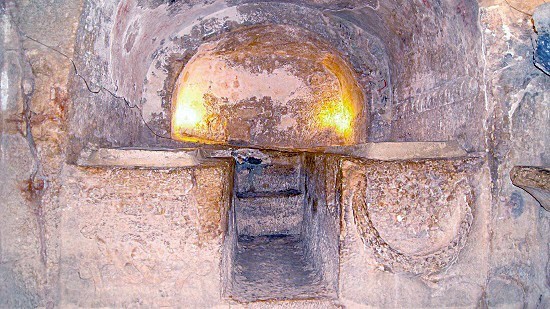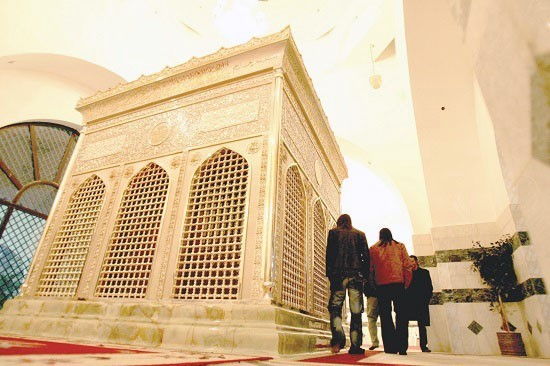Jordan, situated at a crossroads of civilizations, is rich
in history and heritage.
Jordan also abounds in
Islamic monuments. For instance, it
has many shrines and tombs that were a result of the three main strategic
battles fought on Jordan’s territory, — the Mutah, Fahl, and Yarmouk.
اضافة اعلان
 The Cave of the Seven Sleepers. (Photos: Pixabay)
The Cave of the Seven Sleepers. (Photos: Pixabay)
Jordan is where many of the Prophet Mohammad’s companions
were martyred and buried. The country is a significant destination for Muslims
worldwide, as well as for those who desire to learn more about Islamic history.
Jordan is a significant destination for Muslims worldwide, as well as for those who desire to learn more about Islamic history.
Here is a list of some well-known Islamic sites in Jordan:
The Cave of the Seven Sleepers (Ahel Al-Kahf). It is one of
the most popular sites, located 10km east of Amman, near the village of
Al-Raqim. The cave contains eight graves resembling coffins, human remains, and
several artifacts, such as coins belonging to the Islamic, Roman, and Ottoman
eras.
The story of the seven sleepers was mentioned in the Quran,
in Sura Al-Kahf. Around 250 AD, a group of youth and their dog took refuge
inside the cave outside the city of Ephesus to escape religious persecution.
The group slept in the cave for 309 years, as mentioned in the Quran, yet the group
thought that they were asleep for only a day or so. There are still Byzantine
and Roman ruins, and a mosque that matches the description in the Holy
Quran.

Shrine of Ja’far al-Tayyar, located in Al-Mazar, near Karak.(Photo: Wikipe)
Karak Shrines (Tombs of the martyrs of Mutah Battle). The
Mutah Battle that occurred in 629 AD was one of the most significant battles
fought during the Prophet Mohammad’s lifetime. Many of the prophet’s companions
died in this battle, fighting the Ghassanid and Byzantine armies.
In and around Karak, one can visit many other shrines that are significant to Muslims, such as the shrines of the Prophets Noah and Solomon. If you are planning to visit Karak, you should visit these Islamic sites.
The tomb of Zaid Bin Harithah, who led the Muslim army, can
be found in the town of Al-Mazar Al-Janubi, near Karak. The tomb of Jafar Bin
Abi Talib, known as “the flying Jafar”, and the tomb of Abdullah Hin Ruwahah,
who took command of the army after Zaid and Jafar, are in the same town.
In and around Karak, one can visit many other shrines that
are significant to Muslims, such as the shrines of the Prophets Noah and
Solomon. If you are planning to visit Karak, you should visit these Islamic
sites.
The City of Mosaics,
Madaba, is where one of the world’s
largest collections of mosaics is located. One of the most famous is the map of
the Holy Land, which contains around two million pieces of stone tesserae.
 Shrine of Zaid bin Haritha, located in Karak. (Photo: Wikipe)
Shrine of Zaid bin Haritha, located in Karak. (Photo: Wikipe)
Another site is
Mount Nebo, where it is believed that
Prophet Moses stood after leading his people from Egypt across the Sinai Desert
toward the Promised Land. He was buried near Uyun Musa, located near Madaba,
the place where Moses struck a rock with his staff and 12 springs emerged.
The tomb of Abu Dharr Al-Ghifari, who was known for his
generosity and veracity and was among the first companions to follow Islam, is
located in the village of Shaqiq.
 Shrine of Al Harith Bin Omair Al Azdi, located in the Basira district, south of the city of Tafileh. (Photos: Jordan News)
Shrine of Al Harith Bin Omair Al Azdi, located in the Basira district, south of the city of Tafileh. (Photos: Jordan News)
The ancient town of Salt is located northwest of
Amman.
During Ottoman rule, it was the chief administrative center of the region.
Tourists can find several tombs of Islamic figures in and around the city. For
instance, the shrine of the Prophet Shu’ayb lies within a modern mosque in Wadi
Shoaib. The Prophet Shoaib was Moses’ father-in-law. He urged people to abandon
corrupt practices, such as under-weighing the items they sold.
The shrine of the Prophet Ayyoub is located southwest of
Salt in an area called Khirbet Ayyoub. Mausarah Bin Masrouq Al-Abssi, who
witnessed the Prophet Mohammad’s Farewell Pilgrimage and took part in the
conquest of Greater Syria and the Battle of Yamamah, was buried in a town
called Arda, west of Salt.
Read more Where to Go



